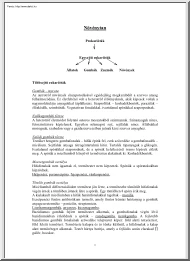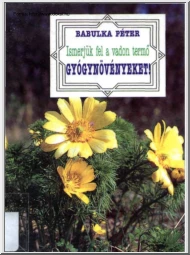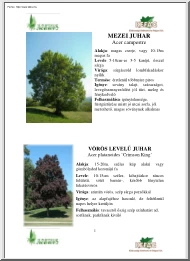Datasheet
Year, pagecount:2013, 2 page(s)
Language:English
Downloads:2
Uploaded:September 20, 2018
Size:696 KB
Institution:
-
Comments:
Attachment:-
Download in PDF:Please log in!
Comments
No comments yet. You can be the first!Most popular documents in this category
Content extract
Source: http://www.doksinet INVASIVE PLANTS OF OHIO Fact Sheet 10 Japanese Knotweed Fallopia japonica DESCRIPTION: Japanese knotweed is an upright, shrub-like, herbaceous perennial that can grow to over 10 feet in height. The stout, hollow stems are reddishbrown and the nodes are swollen, giving them a bamboolike appearance. Typical of the smartweed family, nodes are enclosed by a modified leaf-like structure. Leaves are alternate and egg-shaped (4-6 inches long and 3-4 inches wide), narrowing to a point at the tip. The minute greenish-white flowers are borne in plume-like clusters in the upper leaf axils in summer and are followed soon after by small shiny, black-winged fruits. There is an ornamental variety with pink flowers. Japanese knotweed was probably introduced from Asia in the late 1800s. It was first introduced as an ornamental and has also been used for erosion control and for landscape screening. It is widely distributed in the US and found throughout Ohio. HABITAT:
Japanese knotweed occupies a wide variety of habitats in many soil types with a range of moisture conditions. It poses a significant threat to riparian areas, where it can survive severe flooding. It is also found along roadsides, lowlying areas, utility rights-of-way, old home sites and along woodland edges and openings. Map based on records as of 2010. INVASIVE CHARACTERISTICS: Japanese knotweed grows aggressively by extensive rhizomes forming dense thickets. It is often transported to new sites as rhizome and seed contaminants in fill dirt. It is a threat to riparian areas as small pieces of rhizome washed downstream can establish new colonies. Neglected gardens and discarded cuttings are common routes of dispersal from urban areas. Source: http://www.doksinet CONTROL: Mechanical: Large colonies are extremely difficult to dig due to their high rhizome densities. Digging of large colonies is not recommended as it is very labor intensive and unlikely that all below ground
material can be removed. Small patches may be dug; however, care should be used in removing plant material and placing it in plastic bags for proper disposal. Repetitive cutting or mowing within a single growing season has been effective. Eradication of the rhizome system is necessary for complete control Chemical: Knotweed flowers Systemic herbicides have been generally effective at controlling Japanese knotweed. Repetitive cutting of stems combined with spot application of Roundup, Accord, Glypro, AquaNeat, Rodeo, Habitat/Polaris, or Garlon 3A on the re-sprouting leaves, as well as foliar spraying in large populations will control knotweed populations. Due to the extensive rhizome system, multiple herbicide applications may be required. Best control has been obtained in Ohio with Roundup and Habitat. Some herbicides are approved for wetland or riparian use (e.g, Accord, Glypro, AquaNeat), while others should only be used in upland sites. To be most effective, many herbicides require
a penetrating or sticking agent such as Nu-Film-P. Biological: There are numerous insects and pathogens that attack the species in its natural habitats. No research has been conducted on these possible biological controls Credits and additional information: Plant Conservation Alliance-Alien Plant Working Group Ohio Department of Natural Resources, www.ohiodnrgov The Nature Conservancy, Ohio Chapter Cornell University, www.invasiveplantsnet OIPC website, www.oipcinfo
Japanese knotweed occupies a wide variety of habitats in many soil types with a range of moisture conditions. It poses a significant threat to riparian areas, where it can survive severe flooding. It is also found along roadsides, lowlying areas, utility rights-of-way, old home sites and along woodland edges and openings. Map based on records as of 2010. INVASIVE CHARACTERISTICS: Japanese knotweed grows aggressively by extensive rhizomes forming dense thickets. It is often transported to new sites as rhizome and seed contaminants in fill dirt. It is a threat to riparian areas as small pieces of rhizome washed downstream can establish new colonies. Neglected gardens and discarded cuttings are common routes of dispersal from urban areas. Source: http://www.doksinet CONTROL: Mechanical: Large colonies are extremely difficult to dig due to their high rhizome densities. Digging of large colonies is not recommended as it is very labor intensive and unlikely that all below ground
material can be removed. Small patches may be dug; however, care should be used in removing plant material and placing it in plastic bags for proper disposal. Repetitive cutting or mowing within a single growing season has been effective. Eradication of the rhizome system is necessary for complete control Chemical: Knotweed flowers Systemic herbicides have been generally effective at controlling Japanese knotweed. Repetitive cutting of stems combined with spot application of Roundup, Accord, Glypro, AquaNeat, Rodeo, Habitat/Polaris, or Garlon 3A on the re-sprouting leaves, as well as foliar spraying in large populations will control knotweed populations. Due to the extensive rhizome system, multiple herbicide applications may be required. Best control has been obtained in Ohio with Roundup and Habitat. Some herbicides are approved for wetland or riparian use (e.g, Accord, Glypro, AquaNeat), while others should only be used in upland sites. To be most effective, many herbicides require
a penetrating or sticking agent such as Nu-Film-P. Biological: There are numerous insects and pathogens that attack the species in its natural habitats. No research has been conducted on these possible biological controls Credits and additional information: Plant Conservation Alliance-Alien Plant Working Group Ohio Department of Natural Resources, www.ohiodnrgov The Nature Conservancy, Ohio Chapter Cornell University, www.invasiveplantsnet OIPC website, www.oipcinfo





 Just like you draw up a plan when you’re going to war, building a house, or even going on vacation, you need to draw up a plan for your business. This tutorial will help you to clearly see where you are and make it possible to understand where you’re going.
Just like you draw up a plan when you’re going to war, building a house, or even going on vacation, you need to draw up a plan for your business. This tutorial will help you to clearly see where you are and make it possible to understand where you’re going.